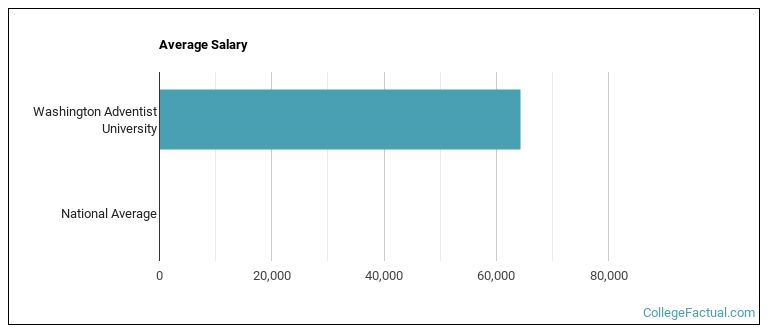 by our College Data Analytics Team
by our College Data Analytics TeamExplore the best ranked schools for the programs you are most interested in.
Washington Adventist University was not ranked in College Factual's 2025 Best Overall Colleges report. This could be for a number of reasons, including lack of data.
See all of the rankings for Washington Adventist University.
If you're applying to Washington Adventist University you'll face some tough competition, since the school's acceptance rate is only 51%. Definitely don't wait until the last minute to submit your application, since applying early may be in your favor.
The student to faculty ratio at Washington Adventist University is an impressive 6 to 1. That's quite good when you compare it to the national average of 15 to 1. This is a good sign that students at the school will have more opportunities for one-on-one interactions with their professors.
Another measure that is often used to estimate how much access students will have to their professors is how many faculty members are full-time. The idea here is that part-time faculty tend to spend less time on campus, so they may not be as available to students as full-timers.
The full-time faculty percentage at Washington Adventist University is 16%. This is lower than the national average of 47%.
The freshmen retention rate of 86% tells us that most first-year, full-time students like Washington Adventist University enough to come back for another year. This is a fair bit higher than the national average of 68%. That's certainly something to check off in the good column about the school.
When we say that a student has graduated on time, we mean that they have finished their bachelor's degree within four years. The on-time graduation rate at Washington Adventist University is 20%. That's lower than the national rate of 33.3%
Find out more about the retention and graduation rates at Washington Adventist University.
During the 2017-2018 academic year, there were 845 undergraduates at Washington Adventist University with 624 being full-time and 221 being part-time.
| $0-30 K | $30K-48K | $48-75 | $75-110K | $110K + |
|---|---|---|---|---|
| $13,119 | $16,806 | $15,953 | $21,686 | $25,295 |
The net price is calculated by adding tuition, room, board and other costs and subtracting financial aid.Note that the net price is typically less than the published for a school. For more information on the sticker price of Washington Adventist University, see our tuition and fees and room and board pages.
It's not uncommon for college students to take out loans to pay for school. In fact, almost 66% of students nationwide depend at least partially on loans. At Washington Adventist University, approximately 65% of students took out student loans averaging $8,874 a year. That adds up to $35,496 over four years for those students.
Get more details about paying for Washington Adventist University.

See which majors at Washington Adventist University make the most money.
Get more details about the location of Washington Adventist University.

Contact details for Washington Adventist University are given below.
| Contact Details | |
|---|---|
| Address: | 7600 Flower Ave, Takoma Park, MD 20912 |
| Phone: | 301-891-4000 |
| Website: | https://www.wau.edu/ |
| Most Popular Majors | Bachelor’s Degrees | Average Salary of Graduates |
|---|---|---|
| Nursing | 65 | $85,352 |
| Clinical, Counseling & Applied Psychology | 43 | NA |
| Business Administration & Management | 23 | NA |
| Allied Health Professions | 15 | NA |
| Liberal Arts General Studies | 15 | NA |
| Health & Medical Administrative Services | 12 | NA |
| General Biology | 7 | NA |
| Music | 7 | NA |
| Teacher Education Subject Specific | 6 | NA |
| Theological & Ministerial Studies | 5 | NA |
Online learning is becoming popular at even the oldest colleges and universities in the United States. Not only are online classes great for returning adults with busy schedules, they are also frequented by a growing number of traditional students.
In 2022-2023, 160 students took at least one online class at Washington Adventist University. This is a decrease from the 418 students who took online classes the previous year.
| Year | Took at Least One Online Class | Took All Classes Online |
|---|---|---|
| 2022-2023 | 160 | 37 |
| 2021-2022 | 418 | 47 |
| 2020-2021 | 825 | 481 |
| 2018-2019 | 162 | 23 |
Learn more about online learning at Washington Adventist University.
If you’re considering Washington Adventist University, here are some more schools you may be interested in knowing more about.
Curious on how these schools stack up against Washington Adventist University? Pit them head to head with College Combat, our free interactive tool that lets you compare college on the features that matter most to you!
Footnotes
*The racial-ethnic minorities count is calculated by taking the total number of students and subtracting white students, international students, and students whose race/ethnicity was unknown. This number is then divided by the total number of students at the school to obtain the racial-ethnic minorities percentage.
References
More about our data sources and methodologies.